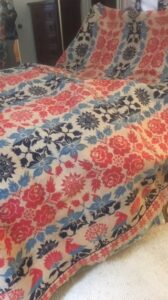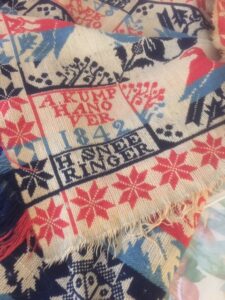 JU sent me an American Jacquard coverlet from the 1840s when almost all rural households owned one of these blankets. Quilts took a long time to make, and NOT from wool. These warmer coverlets came in both cotton and wool warp and weft. Highly decorative, these coverlets bore the name of the maker, place of making, and a patriotic and showy pattern.
JU sent me an American Jacquard coverlet from the 1840s when almost all rural households owned one of these blankets. Quilts took a long time to make, and NOT from wool. These warmer coverlets came in both cotton and wool warp and weft. Highly decorative, these coverlets bore the name of the maker, place of making, and a patriotic and showy pattern.
Weavers who learned on household looms emigrated from Germany and made these coverlets on ‘overshot’ looms. When you turn the coverlet over you won’t see the pattern echoed on the back. English and Scottish emigrants learned to weave as part of their daily chores in the “double weave.” This means you do see the pattern echoed on the back.
In 1820 something wonderful came to America that revolutionized the weaving industry, even for rural weavers. The loom invented in 1800 by Frenchman Joseph Marie Jacquard (1752-1834) became the WORLD’S first punch card analogue computer. If you inserted a punch card in the loom itself, it wove in the spaces the card told it to. Home weavers, or itinerants who pulled a loom on wagon, ‘attached’ a card reader to an existing loom to make it “read” the punch cards.
Intricate Coverlets
 This revolutionary invention provided many households with fairly intricate bed coverlets. These featured custom designs, names, dates, eagles, George Washington, flowers, and all for an inexpensive price. Usually the household displayed and used this prized possession nightly on the bed.
This revolutionary invention provided many households with fairly intricate bed coverlets. These featured custom designs, names, dates, eagles, George Washington, flowers, and all for an inexpensive price. Usually the household displayed and used this prized possession nightly on the bed.
I particularly LOVE two important museums that feature the history of such coverlets because the majority of old coverlets are not expensive to buy at auction, and not easily recognizable as antiques in thrift stores. Electra Havemeyer Webb founded the Shelburne Museum in Shelburne, Vermont. It features circus displays, carriages, decoys, coverlets, folk art, Americana decorative art, and features a loom called a Barn Frame Loom. The National Museum of the American Coverlet based in Bedford, PA, showcases more woven wool and cotton coverlets than quilts, as coverlets were more prevalent. I often slept under one of these warm indigo on cream coverlets designed and dated to 1840.
Fine Jacquard Coverlets
Bleached cotton makes up the foundation of such weavings, then the warp is interfaced with wool, and the weft is the “canvas” for color. Where did home weavers get the colors? From local plants! Many of these coverlets came about PRE synthetic colors for textile dying. Color sources included dogwood, bloodroot which makes red, goldenrod for green, butternut for brown, and Bittersweet to make orange. ONLY after the Civil war did home weavers know of synthetic dyes, which first came out brighter and more strident than natural dyes. The first color invented as a chemical dye was MAUVE.
Weavers understand that a really fine Jacquard coverlet came two-ply with a “z” twist of wool and a yarn count of 18 x 18.5 per square inch. The National Museum of American History has a wonderful example with repeated images of George Washington. Not sure I want to sleep under George, however.
The value of such a coverlet is $500.
Pingback: American Quilt Saga - Elizabeth Appraisals